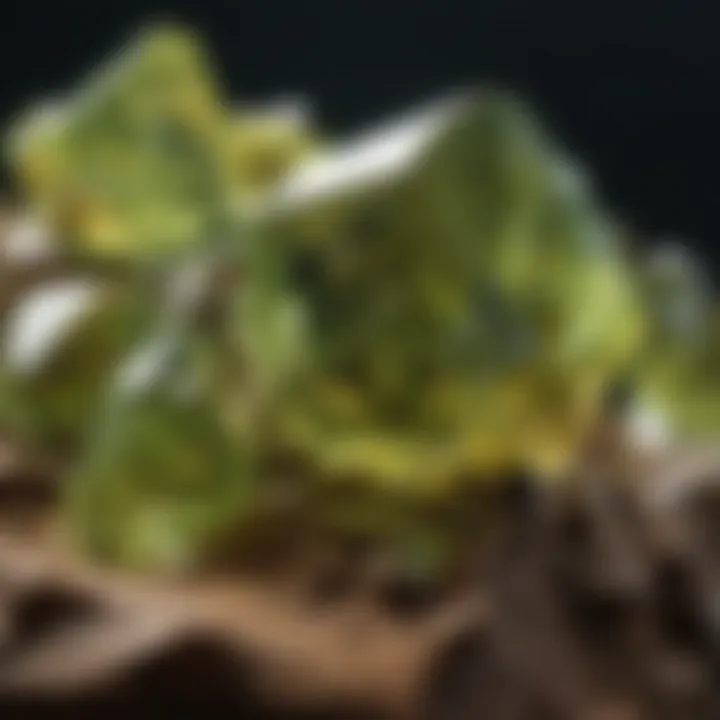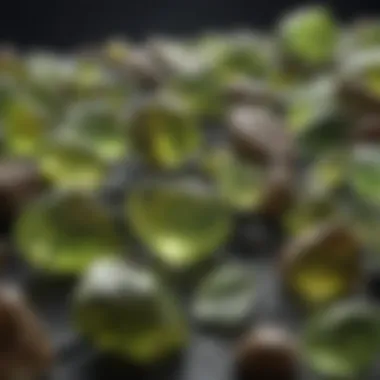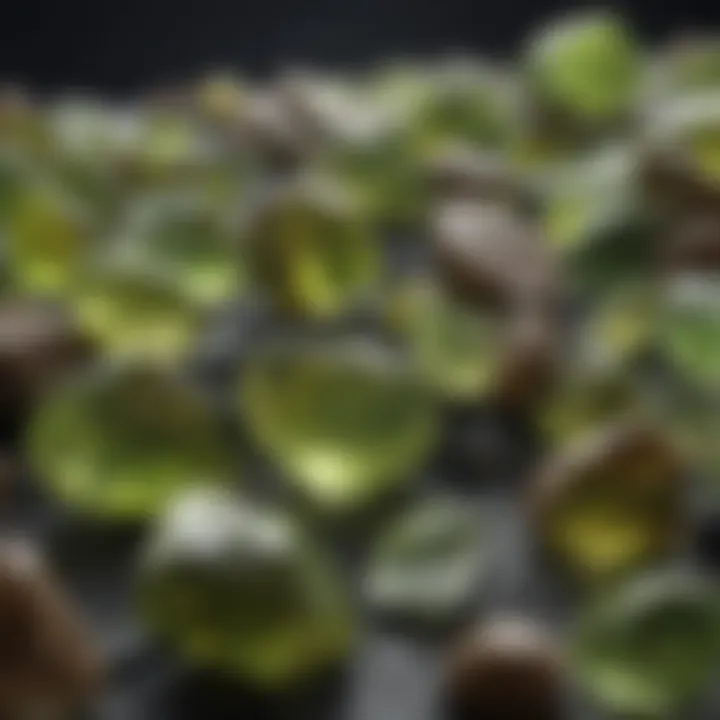Exploring the Fascinating World of Olivine Crystals


Intro
Olivine crystals are a marvel of nature, captivating both scientists and collectors alike. Their vibrant green hues and unique formations have made them a subject of fascination through the ages. As one digs deeper into the world of olivine, it soon becomes clear that there's more to this mineral than meets the eye. From its geological origins to its applications in various industries, olivine holds a significant place in our Earth's story. Whether you're a budding geologist, a seasoned collector, or simply curiously wondering about this striking crystal, this article will shed light on the numerous facets of olivine.
Featured Collectible of the Month
Overview
Among the dazzling array of minerals available to collectors, olivine stands out as a particularly alluring specimen. Commonly found in igneous rocks, olivine can display varying shades of green, from vibrant grass green to a softer olive hue. This mineral not only has aesthetic appeal, but its formation is also a testament to geological processes that give rise to one of the most abundant minerals in the Earth's mantle.
Olivine is most commonly discovered in volcanic rocks, specifically basalt and peridotite. Its presence is an indicator of high-temperature conditions, often formed during the cooling of molten rock. Moreover, olivine's crystals are typically found in a massive or granular form but can occasionally crystallize into the beautiful, transparent, glass-like prisms that collectors crave. Typically, a piece of olivine can range from small chips to sizeable specimens that can weigh several pounds, depending on where they are sourced.
Historical Significance
Historically, olivine has not only been used for ornamental purposes but also held practical value. Ancient civilizations valued olivine as a gemstone. The Romans, for instance, would often incorporate it into jewelry, dubbing it the "evening emerald" due to its luminous quality in candlelight. In the last century, olivine served as an essential component in the production of refractory materials thanks to its ability to withstand high temperatures. This has made olivine a critical mineral in industries such as construction and metallurgy, where durability is key.
"Olivine serves not just as a collectible, but as a testament to Earth's geological processes. Its vibrant colors mirror the processes that bring it to the surface, waiting to impart its ancient secrets to those who seek them."
Identification Techniques
Visual Characteristics
Identifying olivine can be quite straightforward with a keen eye. Here are some visual characteristics to look for:
- Color: Ranging from yellowish-green to dark green, olivine's coloration is often its most distinguishing feature.
- Luster: Olivine has a vitreous (glass-like) luster that can capture light beautifully.
- Transparency: While many specimens are translucent, some high-quality crystals can be wholly transparent.
- Crystal Form: Typically, olivine crystals will form in a granular or massive structure, but look for the distinctive transparent, glassy crystals as ideal collectors' pieces.
Resources for Identification
For those eager to learn more about identifying olivine or confirming their specimens' authenticity, consider these resources:
- The Mineral Gallery online collection which provides extensive descriptions and images of olivine and similar minerals.
- The American Mineralogist journal frequently publishes articles that might give insights into the more technical aspects of olivine and related minerals.
- Forums on Reddit where rockhounds, collectors, and geologists gather discuss identifying unique specimens.
Prelude to Olivine Crystals
Olivine crystals hold a prominent place in both geological studies and the industrial world. Understanding olivine is crucial for enthusiasts who wish to deepen their knowledge of mineralogy and geology. This section sheds light on its unique properties, formation processes, and implications for various fields. Doing so helps to pave the way for a thorough exploration of this remarkable mineral throughout the article.
Definition and Historical Context
Olivine is a magnesium iron silicate mineral, often categorized in two primary forms: forsterite (high magnesium) and fayalite (high iron). Named after the olive-green colors it typically displays, its history dates back to its discovery in volcanic rocks. It was first documented in the 18th century; however, its significance wasn't fully appreciated until later research revealed its role within Earth’s mantle. This vibrant mineral is often found in basalt and peridotite, and it garners attention not only for its beauty but also for its geological implications. As geology developed as a science, olivine became an important mineral for understanding the processes occurring beneath Earth’s surface, shining a light on the planet’s formation and evolution.
Importance in Geology and Industry
The relevance of olivine extends far beyond aesthetics. Geologically, it serves as a key indicator of the mantle's conditions and processes. Its presence in basaltic lavas can give insights into the temperatures and pressure conditions under which these rocks form.
In industry, olivine is used in processes ranging from metallurgy to environmental applications. For instance, during steel production, olivine sand can act as a flux, helping to remove impurities. Furthermore, it is gaining traction as a potential material in carbon sequestration technologies, holding promise for mitigating climate change.
"Olivine’s unique capabilities to bind atmospheric CO2 are paving the way for innovative solutions in environmental sciences."
Olivine crystals, therefore, sit at the intersection of natural beauty and scientific utility, warranting deeper examination of their forms, structures, and applications. Through this exploration, collectors and professionals alike can gain a more nuanced understanding of olivine's myriad of uses in our modern world.
Chemical Composition of Olivine
The chemical composition of olivine is a cornerstone of understanding this remarkable mineral. It sheds light on not only its properties but also its role in various geological and industrial contexts. Comprising primarily of magnesium and iron silicate, olivine holds a unique position among silicate minerals. In this section, we will dissect the mineral groups that olivine belongs to, and explore its key elements and variants.
Mineral Groups and Formula
Olivine is primarily classified within the silicate mineral group, which is comprised of various types of minerals formed through the combination of silicon and oxygen with metal cations. The basic chemical formula of olivine typically can be expressed as (Mg, Fe)₂SiO₄.
- Compositional Variety:
- Widespread Occurrence:
- In this structure, magnesium (Mg) and iron (Fe) can substitute for one another in various proportions. As a result, different types of olivine can be formed, referred to specifically as forsterite when magnesium predominates, and fayalite when iron is more prevalent.
- Given its formation under high-temperature conditions, olivine is often encountered in igneous rocks, such as basalt and peridotite. These kinds of rocks typically form from cooling magma beneath the Earth's surface. Thus, olivine serves as a useful indicator of the conditions in which the rock formed.
Understanding the mineral groups and the formula of olivine is vital for collectors and geologists alike. It helps in identifying the specific types of olivine samples that a collector may come across and gives insights into the geological environments from which they originate.


Key Elements and Variants
Olivine is composed of several key elements that not only determine its composition but also influence its physical and optical properties. The primary components include:
- Magnesium: The presence of magnesium typically leads to a more stable and resilient crystal structure, making forsterite variants spectacular when they form in well-formed crystals.
- Iron: Fayalite, containing iron, is often less stable than forsterite, leading to variants that may be more prone to weathering when exposed to atmospheric conditions. The difference in stability between these two components can influence how olivine is utilized in industrial applications.
- Silicon and Oxygen: These elements form the silicate framework that defines the very structure of olivine crystals. Their ratios define the mineral's properties, including how it interacts with other minerals.
Moreover, the presence of trace elements can modify olivine’s characteristics further. Variants such as nickel- and manganese-rich olivine are known to exist and can be particularly interesting to collectors.
To sum up, comprehending the chemical composition of olivine is crucial not just for mining and extraction industries, but for rock and fossil enthusiasts as well. The interplay between magnesium, iron, and other trace elements opens a door to the depths of olivine's geological narrative and its practical significance in various applications.
"Olivine’s chemical complexity reflects millions of years of geological history, as well as its adaptability in industrial utilization."
This section of olivine lays the groundwork for understanding the aesthetic and economic appeals of this mineral from both a collector's perspective and broader scientific applications.
Crystal Structure and Forms
The crystal structure and forms of olivine crystals are pivotal when it comes to understanding their unique properties and applications. This section elucidates how the arrangement of atoms in olivine not only defines its physical characteristics but also enriches our comprehension of its geological context. Such knowledge is crucial for both collectors and geologists as it unravels the story that these minerals tell about the Earth's processes.
Crystallography Basics
Crystallography is the branch of science that focuses on the study of crystal structures. In olivine, specifically, its orthorhombic crystal system is worth noting. This system means that olivine crystals generally form in elongated shapes with distinct symmetry, which can be astoundingly beautiful when found in nature. The unit cell of olivine consists of a specific arrangement of magnesium, iron, and silicate ions, giving rise to its characteristic greenish hues.
To illustrate, the simplest formula for olivine is (Mg, Fe)2SiO4, which highlights the presence of magnesium and iron within the crystal structure. The variability in the proportions of these elements results in different types of olivine, further showcasing its versatility. This makes olivine purposefully significant in geological studies, especially when we consider its stability under varying temperatures and pressures.
Furthermore, the physical features visible in olivine crystals, such as their vitreous luster and typically conchoidal fracture, stem from this intrinsic structure. Such properties not only hold implications for industrial uses but also play a vital role in the aesthetic appeal for collectors.
Common Forms and Morphologies
When it comes to common forms and morphologies, olivine presents a wide array of variations that enthusiasts might encounter. The more prevalent crystalline forms include:
- Granular Olivine: This form consists of small, tightly packed grains, often found in volcanic rocks.
- Olive Green Crystals: Polished specimens reflecting deep green colors are highly sought after for collections, known as peridot in the gem world.
- Fibrous Olivine: This less common morphology appears in elongated, fibrous structures, typically associated with metamorphic environments.
Notably, it’s worth mentioning that olivine can appear as part of larger rock formations, influencing the geological narrative of an area. Its presence often indicates specific geological processes at play, such as those in the lower mantle where olivine is believed to be stable under extreme conditions.
"Understanding the forms of olivine reveals not just the beauty of its crystals, but a deeper insight into Earth's geological history."
Collectors should pay attention to specific traits when identifying olivine specimens. Characteristics such as crystal size, color variations, and inclusions can provide insight into the origin and quality of the crystal. Keeping these factors in mind can enhance the collecting experience, whether for aesthetic purposes or geological study.
Formation Processes of Olivine Crystals
Understanding the formation processes of olivine crystals is essential not just for geologists but also for collectors and enthusiasts who wish to appreciate the intricate journey these minerals endure from deep within the Earth to their final crystallized state. The processes that lead to olivine's existence involve various geological environments and crystallization methods which can significantly influence the characteristics of the crystals produced. This section will delve into these two aspects, painting a vivid picture of how olivine comes to be.
Geological Environments
Olivine primarily forms in high-temperature environments, often found in igneous rocks like basalt or peridotite. These rocks cool from molten states beneath the Earth's surface, and olivine is one of the first minerals to solidify during this process due to its melting point being quite high when compared to others. The presence of olivine is often associated with:
- Mantle Origins: As a major component of the Earth's upper mantle, olivine provides clues about the planet’s internal processes. Its formation in these depths signifies that crustal movement can expose it, allowing collectors to find it in volcanic areas.
- Magma Chambers: When magma accumulates, the conditions become ripe for olivine cristallization. Its unique ability to tolerate high iron content contributes to the material's appeal in the field.
- Metamorphic Settings: Though less common, olivine can be altered in metamorphic environments under high temperatures and pressures, which may result in unique varieties appreciated by collectors.
"Olivine’s presence in volcanic settings is akin to a signature stamped on the landscape—the invaluable record of Earth’s ongoing geological story."
These environments are more than mere contexts; they shape the olivine’s characteristics—its color, clarity, and even the intensity of its green hues. Collectors who understand these settings can better appreciate the geological history encapsulated in each specimen.
Crystallization from Magma
The crystallization process of olivine from magma is a fascinating affair. This process is marked by several stages that determine the final product's form. When magma begins to cool, olivine crystals start forming as they exceed their solubility limits in the liquid rock. Here’s a basic overview of what happens:
- Nucleation: Tiny olivine crystals start to form from dissolved minerals in the magma. This initial phase is crucial, as the conditions dictate whether the crystals will grow large or remain small.
- Crystal Growth: As cooling continues, these nascent crystals begin to grow. Factors such as temperature, pressure, and the localized chemical composition of the magma influence their size and shape. Rapid cooling may lead to smaller grains, while slower cooling allows for larger specimens with distinct shapes.
- Incorporation of Elements: During crystallization, olivine can absorb various trace elements from the surrounding magma, creating distinct varieties. For example, the presence of manganese might yield a different tint compared to its iron-rich kin.
The complexity of crystallization from magma also hangs on the various textures and morphologies of olivine. Experts and collectors place value on these attributes, as they can denote both aesthetic appeal and the particular geological journey of each crystal. Understanding these processes not only enhances appreciation but also aids collectors in identifying genuine specimens.
In sum, the formation processes of olivine crystals provide profound insights into both geological activity and the intricacies of Earth’s interiors. By recognizing the environments in which olivine thrives and the mechanisms behind its crystallization, collectors and enthusiasts can enrich their understanding and foster a deeper connection with this captivating mineral.
Geological Significance of Olivine
Olivine stands out as a pivotal player in geological sciences, intertwining with various processes and forming a crucial element in understanding Earth's deeper layers. It doesn't just sit there as a pretty crystal; rather, it acts as a window into the planet’s past and present. Studying olivine is akin to peering through a crystal ball, revealing insights into the dynamics of the Earth’s interior and even the processes that shape our environment.


Role in Earth’s Mantle
Delving into the role olivine plays in the Earth’s mantle opens a treasure trove of geological knowledge. As one of the most abundant minerals found in this layer, olivine serves as the principal component of peridotite, the rock type that makes up the upper mantle. Its composition, primarily magnesium silicate, allows it to withstand enormous pressures and temperatures, painting an intricate picture of how our planet functions beneath the surface.
Olivine's high thermal conductivity also implies that it plays a vital role in magma formation and movement. When mantle rocks begin to melt, olivine can crystallize from the molten material, leading to the formation of basalt and other volcanic rocks when the magma reaches the surface. Thus, olivine isn't just a participant; it’s a key player in the rock cycle, influencing the types of volcanism and tectonics that occur over geological time scales. It's like a storyteller weaving narratives about the Earth's journeys!
Indicators of Geological Activity
Olivine crystals are often heralds of geological activity. For geologists and rock collectors, their presence in igneous rocks can indicate past volcanic events, while their abundance might suggest the cooling history of magma chambers. More specifically, olivine's olivine-wollastonite thermometer enables scientists to estimate the temperatures of magma during its formation.
Furthermore, olivine weathers to form serpentine under specific conditions, which can indicate chemical exchanges between rock and water. This transformation not only signals changes in environmental conditions but also serves as an important indicator of past atmospheric and hydrospheric landscapes. In a sense, olivine acts like a geological diary, encoding events and transformations that have occurred over eons.
"Olivine opens a window into Earth’s complex processes, revealing not just the composition but the stories of our planet’s behavior over time."
Given these facets, olivine evokes great interest among researchers. With advancements in geochemistry and mineralogy, the ongoing study of olivine continues to unveil new interpretations regarding the Earth’s mantle dynamics.
Collectively, the geological significance of olivine cannot be overstated. It influences our understanding of planetary evolution, volcanic activities, and even the very composition of continents. For rock and fossil collectors, gathering olivine samples isn’t just about possession. It’s about holding a fragment of a narrative wrapped in the Earth’s own history.
Olivine in Collecting and Display
The world of mineral collection is not just a simple pastime; it’s a passionate pursuit for many collectors who seek distinct and valuable specimens. Olivine crystals hold a special place in this realm, owing to their unique characteristics and aesthetic appeal. Understanding olivine’s properties and knowing how to identify quality specimens are essential for any collector looking to enhance their collection with this intriguing mineral. In addition, the way these pieces are curated and displayed can significantly impact their appreciation and value within the community.
Identifying Quality Specimens
When it comes to identifying quality olivine specimens, a few crucial factors come into play. The color, clarity, and crystal size stand out as primary indicators of a specimen's value. Most olivine crystals exhibit rich shades of green, but some may present yellowish or brownish tones. Here’s a checklist to consider:
- Color: Look for vibrant green colors, which typically indicate higher quality.
- Clarity: Transparent or translucent crystals are preferred, as inclusions can diminish aesthetic appeal.
- Size and Shape: Larger, well-formed crystals tend to be more sought after. Ideally, they should display the characteristic olivine shape without distortion.
A notable tip is to hold the crystal in different lighting conditions; the play of light can reveal hidden details.
Curation and Display Techniques
Once a collector acquires quality olivine specimens, how these pieces are curated and displayed becomes paramount. The right techniques not only protect the crystals from damage but also enhance their visual impact.
- Proper Shelving: Shelves made from anti-static materials or glass are preferable for dust-free storage. This can help maintain olivine's shine and vibrancy.
- Minimal Handling: As olivine can be sensitive to abrasions, handling them sparingly is advisable. Using gloves when touching them is a good practice.
- Lighting Considerations: Use soft diffused lighting to showcase the specimens’ beauty without generating heat that could degrade their structure over time. Avoid direct sunlight that could fade colors.
- Labeling: Each specimen should be accompanied by a label that includes details like locality, date of acquisition, and any pertinent geological information. This adds educational value for observers and future owners.
"The beauty of olivine cannot be overstated; its rich color and fascinating geological origins make it a prized possession among collectors. Proper care and display can significantly increase both appreciation and value."
For those looking to take their collection to the next level, participating in mineral shows or collector groups can also provide valuable insights into curation. Utilizing platforms such as reddit.com can connect collectors and enthusiasts, offering support and sharing expertise on display strategies and specimen identification.
In summary, olivine crystals represent not just geological marvels but also thoughtful collectibles. Identifying quality specimens and employing effective curation and display techniques ensures that these stunning pieces remain a source of admiration and joy.
Olivine in Industry
In the realm of industrial applications, olivine crystals are far more than mere geological curiosities. Their unique physical and chemical properties have carved a niche for them in various industries, making them invaluable for both economic and environmental reasons. Understanding how olivine participates in industry not only illustrates the multifaceted nature of this mineral but also sheds light on its potential to influence future technological advancements.
Applications in Metallurgy
When it comes to metallurgy, olivine is widely recognized for its role as a refractory material. Refractories are crucial in the manufacturing of metal, serving as a lining in furnaces, kilns, and other high-temperature equipment. Here’s why olivine is preferred:
- High Melting Point: Olivine can withstand extreme temperatures, which is vital during metal refining processes. For instance, it maintains structural integrity even when subjected to temperatures exceeding 1,600 °C.
- Chemical Resilience: The mineral is chemically stable, reducing the risk of contamination during metal processing. For example, in the production of steel, impurities can significantly affect the final quality of the product.
- Low Thermal Expansion: This quality minimizes the risk of cracking under heat stress, thereby prolonging the lifespan of equipment used in metallurgical processes.
These characteristics allow industries to improve efficiency and product quality, making olivine a preferred choice over other refractories.
Utilization in Environmental Solutions
In addition to its metallurgical applications, olivine plays a crucial role in environmental solutions, especially concerning carbon sequestration. This process is vital in combating climate change through reducing carbon dioxide levels in the atmosphere. Here's a breakdown of how olivine contributes to this field:
- Natural Weathering: Olivine reacts with carbon dioxide when exposed to environmental conditions, forming stable carbonates. Hence, minerals that contain olivine can naturally help in capturing CO2, making it a key player in ongoing carbon capture frameworks.
- Soil Remediation: The mineral has shown promise in restoring contaminated sites due to its ability to bind heavy metals. For instance, olivine can interact with cadmium and lead, reducing their bioavailability in soils, ultimately benefitting ecosystems.
- Sustainable Practices: As industries increasingly adopt sustainable practices, olivine's potential for reducing greenhouse gas emissions makes it an important material in green technologies.
"The use of olivine not only facilitates effective carbon capture but also highlights the mineral's adaptability within environmental frameworks."
The significance of olivine in these contexts cannot be understated. As industries grapple with the pressing challenges posed by climate change and environmental degradation, olivine not only aids in metal production but also contributes to solutions aiming to create a healthier planet.
Olivine and Its Industrial Applications


Olivine crystals hold a significant place in various industrial sectors due to their unique properties and versatility. Understanding their industrial applications not only showcases their utility but also underlines their relevance in advancing technology and improving environmental conditions. As we dive deeper, two notable areas stand out: olivine’s role as a metal production aid and its promise in carbon sequestration technologies. Both these applications highlight olivine's practical benefits and growing significance in addressing contemporary challenges.
Olivine as a Metal Production Aid
The role of olivine in metallurgy is quite pivotal. It primarily acts as a flux in the refining process of metals, particularly in the production of iron and steel. When mixed with other materials, olivine helps to lower the melting point needed to extract metals from their ores. This lowers energy costs and increases the efficiency of production processes.
Here are a few key points regarding olivine's applications in metallurgy:
- Reducing Slag Viscosity: Olivine reduces the viscosity of slag during smelting, which aids in the smooth separation of metals.
- Improved Purity: Using olivine can result in a cleaner final metal product, owing to its ability to bind with impurities during the smelting process.
- Sustainability Aspect: With an increasing focus on sustainable metal production, olivine is advantageous due to its natural abundance and its non-toxic nature compared to alternative fluxing agents.
This operational efficiency and environmental friendliness have made olivine a notable choice among metallurgists.
Use in Carbon Sequestration Technologies
Another compelling application of olivine lies in its potential for carbon sequestration. As climate change becomes a burning issue, innovative solutions for CO2 emissions are highly sought after. Olivine’s high magnesium content allows it to react with atmospheric carbon dioxide, facilitating the mineralization process.
This process can be outlined as follows:
- CO2 Absorption: Olivine reacts with CO2 through a chemical process that converts the gas into stable carbonate minerals. This significantly reduces the atmospheric concentration of carbon.
- Potential for Large-Scale Application: With the right implementation, olivine can be utilized on a large scale, particularly in areas with volcanic activity where olivine-rich rocks are prevalent.
- Enhanced Soil Stability: When olivine is spread over agricultural land, it not only aids in carbon capture but also improves soil stability and nutrient content, offering dual benefits.
Olivine's dual potential—supporting metal production while combating climate change—makes it a mineral of considerable interest in current research and industrial innovations. Given the growing demands of the industrial sector and environmental sustainability, olivine is likely to play an increasingly vital role.
"The multi-faceted applications of olivine indeed mark it as a cornerstone mineral for both metallurgy and environmental solutions."
Olivine’s versatility reinforces its importance in modern industries while paving the way for sustainable practices that are gaining traction globally.
Research and Innovations
Research and innovations regarding olivine crystals are central to understanding this mineral beyond its geological origins. The exploration of olivine's properties has opened up various avenues in scientific inquiry, particularly in materials science and environmental studies. As industries continue to grapple with the challenges of sustainability and efficiency, olivine emerges as a promising candidate for diverse applications.
Current Research Trends
Researchers today are focusing on several key areas involving olivine. One prominent trend is its role in carbon capture technologies. Scientists are investigating how olivine can aid in sequestering carbon dioxide from the atmosphere. This is crucial in a time when reducing greenhouse gas emissions is of utmost importance. The mineral's ability to react with CO2 helps mitigate climate change, and ongoing studies aim to optimize the chemical processes involved.
Another area of active research is the examination of olivine's effectiveness as a catalyst in various chemical reactions. For example, olivine is being looked at for improving the efficiency of reactions in metallurgical processes. This not only enhances the quality of metal production but also reduces energy consumption. The dual advantage of cost-saving and environmental benefits makes olivine a focal point in current industrial research.
"In the quest for greener technologies, olivine presents itself not just as a mineral, but as a potential game-changer in both industry and environmental sustainability."
Researchers are also delving into olivine's structural properties, which can inform the development of new materials. Understanding its crystallography can lead to the formulation of innovative composite materials that capitalize on olivine's lightweight and thermal stability characteristics.
Future Potential in Science and Industry
The future of olivine in science and industry appears bright, a view supported by numerous studies. One possibility lies in its usage within battery technology. Researchers are exploring how olivine can be integrated into lithium-ion batteries, potentially improving their efficiency and sustainability. The shift towards renewable energy sources escalates the demand for reliable battery technologies, and olivine may play a pivotal role in this evolution.
Moreover, given the increasing concerns about soil health, olivine's properties could be harnessed in agriculture. Studies suggest that incorporating olivine into soil can help enhance nutrient availability and contribute to soil remineralization efforts. Such practices can foster sustainable farming by improving crop yields while maintaining soil integrity.
Lastly, the extraction and utilization of olivine in glass and ceramics industries may experience innovation. With the ongoing need for improved materials that can withstand high temperatures and provide durability, olivine's unique properties could align perfectly with these industry demands.
As research progresses, the potential applications of olivine in technology and environmental strategies could redefine its place in both the marketplace and the natural sciences. The interplay between ongoing studies and practical applications reaffirms olivine's significance, suggesting that the best has yet to come.
Closure and Future Outlook
As we wrap up our exploration into the world of olivine crystals, it becomes clear that this mineral possesses a wealth of significance beyond just its striking beauty. As mentioned throughout the article, it serves not only as an essential piece of the puzzle in geological studies but also showcases versatility across various industries. The conclusion brings together the insights gathered from the previous sections, hinting at the prospective pathways for future studies and applications of olivine.
Summary of Key Points
Reflecting on the discussion, several key points stand out:
- Diverse Composition and Structure: Olivine’s unique chemical composition, primarily consisting of magnesium and iron silicate, sets it apart from other minerals. The intricacies in its crystal structure add to its classification significance.
- Geological Role: The presence of olivine in the Earth’s mantle provides vital clues about tectonic activities and the planet’s formation processes.
- Industrial Usage: Ranging from metallurgy to environmental solutions, olivine has proven itself as a crucial asset in various industries, opening doors for innovative applications.
- Research Trends: The ongoing research into olivine’s properties continues to yield new insights that benefit both scientific communities and practical applications.
It's clear olivine is more than just a geological artifact; it's a testament to the Earth's history and potential advancements.
Ongoing Importance of Olivine Crystals
The lasting impact of olivine extends to multiple spheres, making it essential for both collectors and industries alike. Collectors appreciate olivine not only for its beauty and variety but also for the stories it tells about our planet's past. This mineral helps to bridge the gap between aesthetics and science, serving as a focal point for those interested in geology and mineralogy.
From an industrial perspective, olivine's role is expected to expand in the realms of sustainability and technology. Its use in carbon sequestration, for instance, represents significant potential in our fight against climate change. By capturing and storing carbon dioxide, olivine might play a pivotal role in reducing greenhouse gas emissions.
Moreover, the awareness around olivine's geochemical behaviors may influence how industries approach mineral extraction and utilization in future technologies. The research community is also keenly interested; ongoing investigations promise to deepen our understanding of how olivine can be harnessed in upcoming scientific advancements.
"Understanding the nuanced role of olivine could lead to revolutionary strides not just in geology, but in industrial applications that breathe fresh life into the environment."
Thus, the future of olivine crystals appears bright, laden with opportunities that beckon both researchers and enthusiasts alike. Keeping a keen eye on this mineral's evolving significance will surely reward those who endeavor to learn about it.



